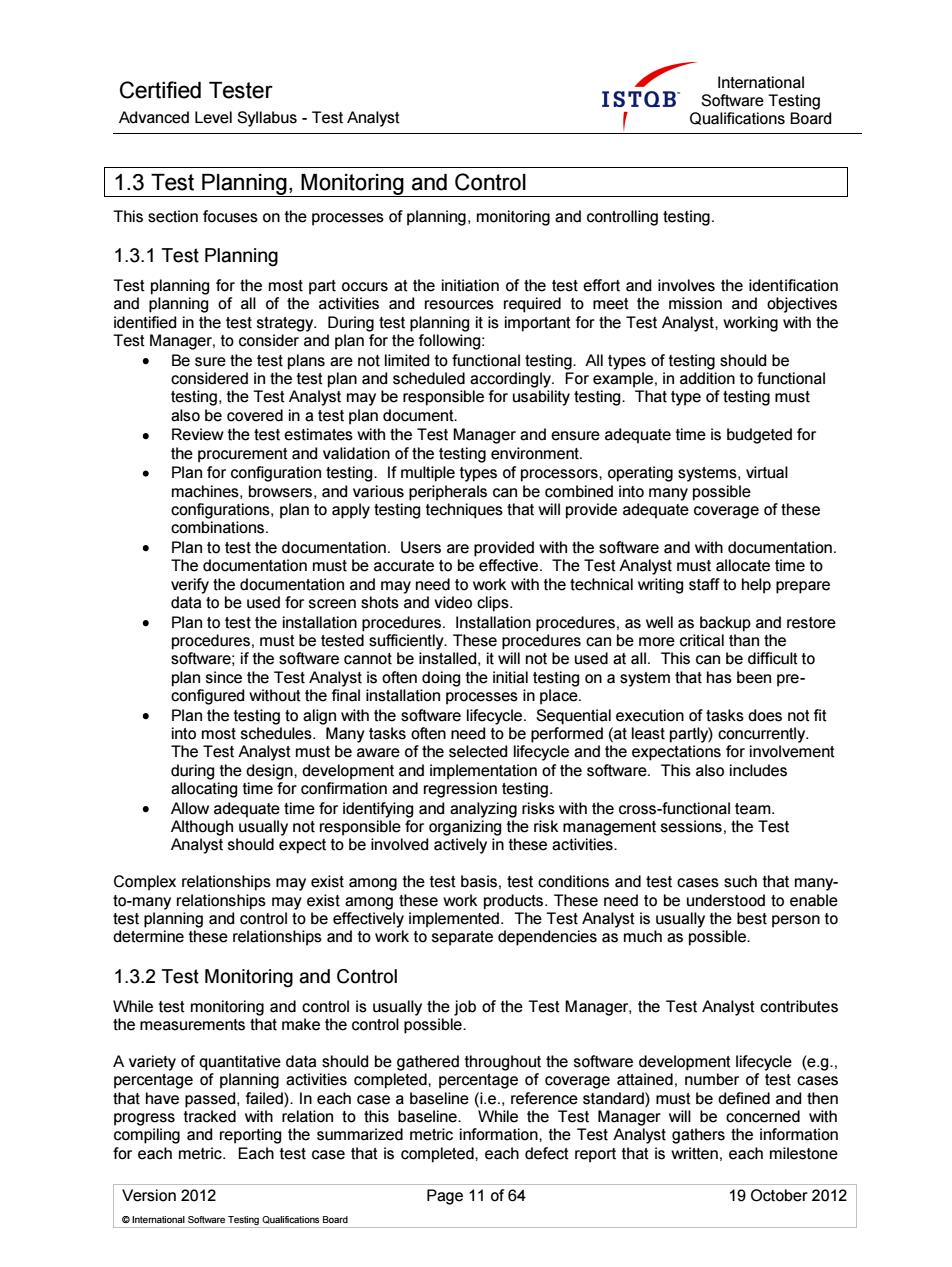正在加载图片...

Certified Tester ISTQB Advanced Level Syllabus-Test Analyst Qualifications Board 1.3 Test Planning,Monitoring and Control This section focuses on the processes of planning,monitoring and controlling testing. 1.3.1 Test Planning ng for the most part rant for h Test Analyst.n al testin All types of test considered in the test plan and scheduled accordi Ana lyst may be responsible for usability testing.That type of testing must Review the test estimate with the Test Manager and ensure adequate time is budgeted for the procurement and validation of the testing environment. tesing If multiple types systems virtual Plan to test the documentation. Users are provided with the sot rify the documentation and may need to work with the technical witing staff to help pre data to be used for screen shots and video clips. ParotetthegsteilatoegPrcer software if the soware cannot e instaled.it winot pe used at all.This can pe dificult to a6 ntia does not fit The Test An alyst must be aware of the selecte and the expe Allwtimeornangh thesfim. for organiz Compiexoatonshipsmayexistamonghetestbasstestcondtonsandtestcasessuobhatmap ted.The Test Analyst is ust y th est person to 1.3.2 Test Monitoring and Control ofh Tet Manager.he Test trol is usual data ould be s01 that have passed.failed).In each cas se a baseline(i.e..reference st ndard)must be defined and then progress with 9 for each metric.Each test case that is completed.each defect report that is written.each milestone Version 2012 Page 11 of 64 19 October 2012 Certified Tester Advanced Level Syllabus - Test Analyst International Software Testing Qualifications Board Version 2012 Page 11 of 64 19 October 2012 © International Software Testing Qualifications Board 1.3 Test Planning, Monitoring and Control This section focuses on the processes of planning, monitoring and controlling testing. 1.3.1 Test Planning Test planning for the most part occurs at the initiation of the test effort and involves the identification and planning of all of the activities and resources required to meet the mission and objectives identified in the test strategy. During test planning it is important for the Test Analyst, working with the Test Manager, to consider and plan for the following: Be sure the test plans are not limited to functional testing. All types of testing should be considered in the test plan and scheduled accordingly. For example, in addition to functional testing, the Test Analyst may be responsible for usability testing. That type of testing must also be covered in a test plan document. Review the test estimates with the Test Manager and ensure adequate time is budgeted for the procurement and validation of the testing environment. Plan for configuration testing. If multiple types of processors, operating systems, virtual machines, browsers, and various peripherals can be combined into many possible configurations, plan to apply testing techniques that will provide adequate coverage of these combinations. Plan to test the documentation. Users are provided with the software and with documentation. The documentation must be accurate to be effective. The Test Analyst must allocate time to verify the documentation and may need to work with the technical writing staff to help prepare data to be used for screen shots and video clips. Plan to test the installation procedures. Installation procedures, as well as backup and restore procedures, must be tested sufficiently. These procedures can be more critical than the software; if the software cannot be installed, it will not be used at all. This can be difficult to plan since the Test Analyst is often doing the initial testing on a system that has been preconfigured without the final installation processes in place. Plan the testing to align with the software lifecycle. Sequential execution of tasks does not fit into most schedules. Many tasks often need to be performed (at least partly) concurrently. The Test Analyst must be aware of the selected lifecycle and the expectations for involvement during the design, development and implementation of the software. This also includes allocating time for confirmation and regression testing. Allow adequate time for identifying and analyzing risks with the cross-functional team. Although usually not responsible for organizing the risk management sessions, the Test Analyst should expect to be involved actively in these activities. Complex relationships may exist among the test basis, test conditions and test cases such that manyto-many relationships may exist among these work products. These need to be understood to enable test planning and control to be effectively implemented. The Test Analyst is usually the best person to determine these relationships and to work to separate dependencies as much as possible. 1.3.2 Test Monitoring and Control While test monitoring and control is usually the job of the Test Manager, the Test Analyst contributes the measurements that make the control possible. A variety of quantitative data should be gathered throughout the software development lifecycle (e.g., percentage of planning activities completed, percentage of coverage attained, number of test cases that have passed, failed). In each case a baseline (i.e., reference standard) must be defined and then progress tracked with relation to this baseline. While the Test Manager will be concerned with compiling and reporting the summarized metric information, the Test Analyst gathers the information for each metric. Each test case that is completed, each defect report that is written, each milestone